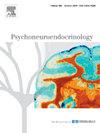Lymphocyte-derived and lipoprotein-derived inflammatory ratios as biomarkers in bipolar disorder type I: Characteristics, predictive values, and influence of current psychopharmacological treatments
IF 3.6
2区 医学
Q2 ENDOCRINOLOGY & METABOLISM
引用次数: 0
Abstract
Purpose of this research
The purpose of this research was to investigate peripheral inflammation by analyzing lymphocyte and lipoprotein-derived inflammatory ratios in patients with bipolar disorder type I (BD-I) and healthy controls (HCs), considering mood stabilizer drug treatments, sex and clinical trajectories.
Methods
This was a cross-sectional case-control study of BD-I patients (n=252) and healthy controls (n=62). We investigated peripheral inflammation biomarkers through blood count values (CBCs), lipoproteins and a complex panel of inflammatory ratios, including the neutrophil-to-lymphocyte ratio (NLR), monocyte-to-lymphocyte ratio (MLR), platelet-to-lymphocyte ratio (PLR), systemic immune-inflammation index (SII), systemic inflammation response index (SIRI), neutrophil-to-HDL ratio (NHR), monocyte-to-HDL ratio (MHR), platelet-to-HDL ratio (PHR) and lymphocyte-to-HDL ratio (LHR). Furthermore, we examined the effects of sex, drug treatment and clinical outcome on the inflammatory profile.
Results
We found that the monocyte-to-lymphocyte ratio (MLR) and lipoprotein-derived inflammatory ratio (NHR, MHR, PHR, and LHR) were significantly greater in BD-I patients than in control individuals. The monocyte-to-HDL ratio (MHR) showed acceptable accuracy as a disease predictor. Logistic regression analysis adjusted for sex, age and BMI indicated that the risk of having a BD-I diagnosis was greater for participants with MHR levels in quartiles 3 (OR= 5.2, p=0.001) and 4 (OR=13, p<0.001). There was a strong association between lithium treatment and increased inflammation represented by elevated lymphocyte-derived inflammatory ratios (NLR, MLR, PLR, SII, and SIRI) in lithium-treated BD-I patients compared to those in lithium-free or lithium treatment-naïve BD-I patients. The main limitations are the cross-sectional nature of the study and limited sample size of HCs.
Major conclusions
Several CBCs, lipoproteins, and a complex panel of inflammatory ratios, including lymphocyte-derived inflammatory ratios (NLR, MLR, PLR, SII, and SIRI) and lipoprotein-derived inflammatory ratios (NHR, MHR, PHR, and LHR), are altered in individuals diagnosed with BD-I. The monocyte-to-HDL ratio (MHR) emerged as a disease predictor in our BD-I sample. A remarkable finding is the association of lithium and valproate treatment with the inflammatory state. Considering the study limitations, our results underscore the importance of pharmacological treatments when researching inflammation markers in mood disorders. Lymphocyte-derived and lipoprotein-derived inflammatory ratios are easy-to-implement and relevant biomarkers in BD-I patients.
作为双相情感障碍 I 型生物标志物的淋巴细胞衍生炎症比率和脂蛋白衍生炎症比率:特征、预测价值以及当前精神药物治疗的影响。
研究目的本研究的目的是通过分析双相情感障碍 I 型(BD-I)患者和健康对照组(HCs)的淋巴细胞和脂蛋白衍生炎症比率来研究外周炎症,同时考虑情绪稳定剂治疗、性别和临床轨迹:这是一项横断面病例对照研究,研究对象为双相情感障碍 I 型患者(252 人)和健康对照组(62 人)。中性粒细胞与高密度脂蛋白的比率(NLR)、单核细胞与淋巴细胞的比率(MLR)、血小板与淋巴细胞的比率(PLR)、全身免疫炎症指数(SII)、全身炎症反应指数(SIRI)、中性粒细胞与高密度脂蛋白的比率(NHR)、单核细胞与高密度脂蛋白的比率(MHR)、血小板与高密度脂蛋白的比率(PHR)和淋巴细胞与高密度脂蛋白的比率(LHR)。此外,我们还研究了性别、药物治疗和临床结果对炎症特征的影响:结果:我们发现,BD-I 患者的单核细胞与淋巴细胞比率(MLR)和脂蛋白衍生炎症比率(NHR、MHR、PHR 和 LHR)明显高于对照组。单核细胞与高密度脂蛋白比率(MHR)作为疾病预测指标的准确性尚可接受。对性别、年龄和体重指数进行调整后的逻辑回归分析表明,MHR 水平在四分位数 3(OR=5.2,p=0.001)和 4(OR=13,p)的参与者被诊断为 BD-I 的风险更大:在被诊断为 BD-I 的患者中,一些全血细胞计数、脂蛋白和一系列复杂的炎症比率,包括淋巴细胞衍生炎症比率(NLR、MLR、PLR、SII 和 SIRI)和脂蛋白衍生炎症比率(NHR、MHR、PHR 和 LHR)都发生了改变。在我们的 BD-I 样本中,单核细胞与高密度脂蛋白的比率(MHR)成为疾病的预测因子。一个值得注意的发现是,锂和丙戊酸钠治疗与炎症状态有关。考虑到研究的局限性,我们的研究结果强调了在研究情绪障碍的炎症标志物时药物治疗的重要性。淋巴细胞衍生炎症比率和脂蛋白衍生炎症比率是 BD-I 患者易于实施且相关的生物标记物。
本文章由计算机程序翻译,如有差异,请以英文原文为准。
求助全文
约1分钟内获得全文
求助全文
来源期刊

Psychoneuroendocrinology
医学-精神病学
CiteScore
7.40
自引率
8.10%
发文量
268
审稿时长
66 days
期刊介绍:
Psychoneuroendocrinology publishes papers dealing with the interrelated disciplines of psychology, neurobiology, endocrinology, immunology, neurology, and psychiatry, with an emphasis on multidisciplinary studies aiming at integrating these disciplines in terms of either basic research or clinical implications. One of the main goals is to understand how a variety of psychobiological factors interact in the expression of the stress response as it relates to the development and/or maintenance of neuropsychiatric illnesses.
 求助内容:
求助内容: 应助结果提醒方式:
应助结果提醒方式:


